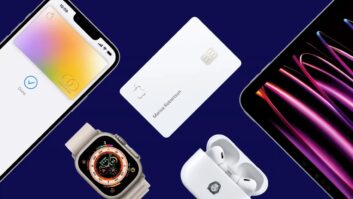NEW YORK — Apple might not boost its shrunken unit share of global tablet sales with the launch of its premium- priced iPad Air and second-generation iPad Mini, but its global tablet sales will resume growth.
Analysts contacted by TWICE also said Apple will win the tablet-profit wars and likely continue to lead the industry in tablet revenues.
In contrast, Nokia’s entry into the tablet market will be challenging, given the company’s reliance on an LTE-equipped 10-inch Windows 8.1 RT model that won’t be available in a Wi-Fi-only version, analysts said. (See TWICE.com for details of the new Apple and Nokia tablets, and the latter’s first phablet.)
Apple’s global iPad sales fell 14 percent in units and 27 percent in dollars in its fiscal third quarter ending in June, and in the fiscal fourth quarter ending in September, iPad sales were flat in units and down 13 percent in dollars.
Apple’s tablet sales were flat to down during the two quarters largely because the company launched new iPads only once in 2013, whereas in 2012, it introduced a new iPad in March and followed that with the November launch of a new iPad and the first iPad Mini, analysts noted.
Despite the sales slide, Apple maintained top unit share worldwide during the first three quarters of 2013, p o s t – ing a 33.5 percent share that exceeded second- place Samsung’s 20.1 percent, IHS statistics show.
“The erosion in Apple’s unit shipment market share was inevitable,” said Rhoda Alexander, tablet research director for IHS. “Cheaper almost always wins the volume race, and competitors were quick to adjust pricing when it became clear that it was impossible to achieve anything close to Apple’s unit growth at the same price level.”
Although Apple might be losing unit share since 2010 when it was largely alone in the tablet market, unit share “tells only part of the story,” said Alexander. “Interestingly, in an environment where competitors on both the Android and Windows sides of the market are using price cuts as their most powerful marketing tool, Apple actually increased its revenue per iPad unit in the third quarter by $3,” Alexander noted.
“In an increasingly bifurcated tablet market, Apple has yet to experience any serious competition for the premier customer, particularly those users wanting to do more with a tablet than watch videos, surf the web and do email,” Alexander noted. “Given Apple’s recent system and software announcements, it is clearly moving beyond the basic consumer tablet market and targeting the remaining personal computer users.”
Apple is on track to lead the tablet market on revenue for years to come, IHS added.
Similarly, Informa analyst Julian Jest said the iPad launches indicate that “Apple is attempting to protect its overall iPad profit margins by using a higher launch price for the iPad Mini with Retina and also making a minimal price reduction of $30 of the original iPad Mini, which will now retail for $299.” The iPad Mini price “was right for customers but not for Apple,” he said.
With the launches, Apple isn’t targeting the price-conscious consumer targeted by companies with sub-$250 tablets and in some cases the sub-$150 price range, Jest added. “And even with the recent reduction in retail price of the [first-generation] iPad Mini to $299, it is unlikely that Apple will be able to sway price-conscious consumers.
Jest saw a potential downside to Apple’s strategy, however. “Apple’s new iPad offerings are probably the most refined and well-crafted tablets on the market. However, at the pursuit of higher profit margins, Apple is now backtracking on pricing for its iPad Mini range, which may have adverse effects, such as pushing more consumers toward purchasing the first-generation model [at $299] rather than the second-generation model.”
Each version of the second-generation Mini is priced $70 higher than its predecessor, with the opening-price Wi-Fi version with 16GB of memory at $399, up from the previous version’s opening price of $329.
The full-size 9.7-inch iPad Air, like its predecessor, starts at $499 for the 16GB Wi-Fi-only version.
IDC analyst Tom Mainelli said Apple’s unit share might not rise with the launches, but iPad sales will accelerate. “Apple will have two premium-priced tablets for the holidays,” he said, given the new Mini’s Retina display and use of the same 64-bit processor as the iPad Air. “People will pay the premium for Apple products compared to 7-inch tablets at a lower cost,” he told TWICE.
Informa analyst Nick Thomas pointed out that “Apple may lose market share as cheaper devices come onto the market, but there should be little cause for concern in Cupertino.” For now, he said, “there is room for both Apple and its competitors to grow. Market share alone is a misleading metric when the whole tablet market is set to grow so rapidly.”
Independent analyst Mark Lowenstein noted that with Apple’s tablet share already high, he isn’t sure the new products will increase the company’s tablet share. “If they maintain share with so many competing products, even that will be a challenge,” he said. “If they can maintain share as the category grows, that will be a great story.”
Apple, he noted, “is comfortable with the position of being a premium brand [in tablets].” And with good reason, he said. “The best Android phones give the iPhone a run for the money. That’s not true for tablets.”
As for Nokia’s launch of a Windows RT tablet, analysts see a rough road ahead. IDC’s Mainelli pointed out that only two companies — Microsoft and Nokia — have launched new RT models in time for the holiday season in the U.S.
With the price of tablets running the full Windows 8.1 OS coming down, with their performance rising with the inclusion of Intel chips, and with more Windows 8.1 models coming with detachable keyboards as standard equipment, Windows RT tablets aren’t gaining traction, he said.
The Nokia tablet is “the most interesting, best-designed product that nobody will buy,” Mainelli said.
Other challenges include availability in only an LTE/Wi- Fi version and its price at a relatively high $499 without optional $150 keyboard compared to Microsoft’s Surface 2 at $449 plus $129 keyboard. “You want RT because it runs Microsoft Office [and Outlook], and that really needs a keyboard,” he said.
For his part, Lowenstein said LTE doesn’t add much to the Nokia tablet’s cost, and users don’t have to purchase a two-year plan but can purchase day passes or week passes on an as-need basis.
One opportunity for the Nokia tablet is in the enterprise, given that the tablet runs Office and Outlook, he noted.
Informa’s Jest agreed. “Microsoft’s best chances of success could come via its corporate customers looking to replace aging laptops.”
Informa analyst Malik Saadi sees an additional niche. The lack of a Wi-Fi-only version “means Nokia aims to use operators as the primary channel for its tablets,” he said.
“This sounds like a good strategy. The operators are being offered a medium to promote LTE usage at a reasonable level of device subsidy, which could enable them to create attractive data-plan offers for their subscribers.” However, 10-inch tablets like the new Lumia 2520 are used mostly in homes, where a Wi-Fi-only model suffices, he said.
Saadi added, “This behavior is largely associated with the tablets’ large form-factor, which doesn’t always make them convenient for the user to carry.”













